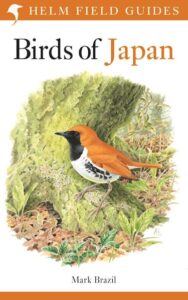 While it’s admittedly not exactly a “new” book – being published in 2018 – I have for too long neglected to enter any notice here of Mark Brazil’s very important and, in terms of books presently in print in English, nearly unique field guide Birds of Japan (yes, the second edition of Tadao Shimba’s Photographic Guide to the Birds of Japan and North-east Asia was published in 2019, but it is a photographic guide, a format that in my estimation will always take second position behind a truly well-crafted illustrated edition). And seeing as how the rest of the books I’ve written about this week have taken as their subjects different aspects of the natural history of Asian countries, I thought I should keep the theme going. Besides, I’ve noticed quite a few news headlines referencing Japan this past fortnight. I think there is some manner of sporting event occurring there…
While it’s admittedly not exactly a “new” book – being published in 2018 – I have for too long neglected to enter any notice here of Mark Brazil’s very important and, in terms of books presently in print in English, nearly unique field guide Birds of Japan (yes, the second edition of Tadao Shimba’s Photographic Guide to the Birds of Japan and North-east Asia was published in 2019, but it is a photographic guide, a format that in my estimation will always take second position behind a truly well-crafted illustrated edition). And seeing as how the rest of the books I’ve written about this week have taken as their subjects different aspects of the natural history of Asian countries, I thought I should keep the theme going. Besides, I’ve noticed quite a few news headlines referencing Japan this past fortnight. I think there is some manner of sporting event occurring there…
But back to the book.
As one who has many times visited Japan – with a binocular always close-at-hand for “crime of opportunity” birdwatching whenever possible – the best I’ve been able to do for a field guide have been books written in Japanese, of which I could only make use of the pictures and the Latin binomials, or books that cover a much larger geographic range that are generally too bulky to tote around, and then don’t generally contain the detail about Japan I needed anyway.
BirdLife International officially cites Japan as having 447 bird species, 50 of which are classified as globally threatened and 21 are determined to be breeding endemics. Birds of Japan includes 738 bird species and subspecies, each vividly illustrated in full color, with extensive supporting texts and range maps. As a result, having this book along on any birdwatching trip, nature ramble, or other adventure you’d care to undertake in Japan will ensure that you’re more than sufficiently prepared to solve any avifauna-related identification challenge that may present itself.
Of course, in our present times travel to such locations of sublime beauty as Japan aren’t either feasible or particularly recommended; however that is bound to change at some time in the future, and if you’re like me, you likely enjoy simply reading through a well-written field guide filled with interesting species just for for relaxation.
And when we are more freely traveling once again, if Japan is on your destination list, you’ll most certainly want to contact the author of Bird of Japan – Mark Brazil – who just happens to also be the founder of Japan Nature Guides, the finest source of information in English of which I know about the natural history of Japan and the very best birding guide to be found there.
Available from:
If you enjoyed reading this, please consider signing up for The Well-read Naturalist's newsletter. You'll receive a helpful list of recently published reviews, short essays, and notes about books in your e-mail inbox once each fortnight.

